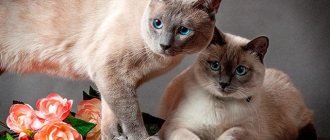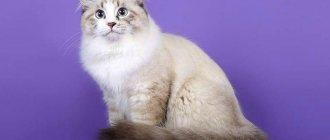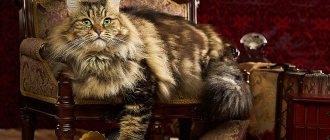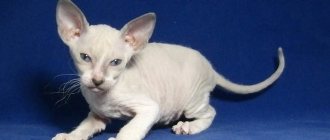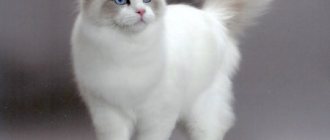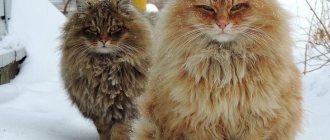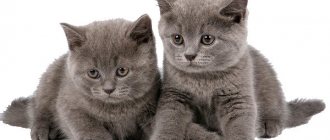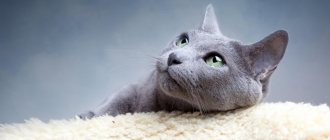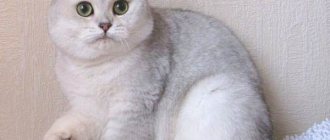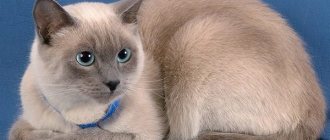Back in 1964, breeder and geneticist from Great Britain Patricia Turner decided to surprise the whole world with a new breed of dazzlingly white cats. This idea came to Patricia after she saw an overexposed photo of a lilac Siamese cat. Until this time, there were only 2 pure white breeds: Angora and Persian. All of them had one characteristic feature - hearing loss. This feature was a genetic defect and led to complete or partial hearing loss. For this reason, in some countries, for example, in Germany, their breeding was prohibited and equated to a crime.
It turned out to be very difficult to get the desired kitten; the experiments were difficult and long. In their process, it turned out that crossing 2 blue-eyed cats leads to complete deafness in absolutely all offspring. As a result of long work and numerous crossings of the Siamese breed, Turner managed to breed white-haired cats with blue eyes and excellent hearing. This result was achieved due to the fact that Siamese cats were kept in isolation for a long time and the genes that cause deafness did not penetrate into them.
The new breed was born by crossing a Siamese cat with a solid white domestic cat. The Foreign White became the world's first completely white breed that was not albino and did not suffer from deafness. These cats are also called Siamese Whites, White Foreigners or White Oriental Shorthairs. In 1966, at an exhibition in England, the breed was officially recognized and certified, receiving high expert ratings. In the 70s of the 20th century, the new breed was registered by almost all international associations: ACF, GCCF, CCCA, WCF.
Leave the content of the British
British cats are short-haired, so they are brushed at least once a week, and every other day during heavy shedding.
To care for the fur, use standard “cat” combs or special gloves, which can be purchased at a pet store. The presence of slight discharge from the eyes and nose is normal for the British Fold cat. The owner needs to regularly carry out hygiene procedures - clean the nose and eye area from dirt.
Particular attention should be paid to cleaning the ears of a British Fold cat.
The unusual structure of the shell complicates the procedure, so you need to act very carefully so as not to harm your pet
First, the bent tip of the ear is bent and access to the inside is freed. Using a cotton swab, carefully clean the areas that are in your field of vision. For deeper cleaning, use special ear drops or other preventive liquid preparations that can be injected into the ear canal.
Unusual cat behavior is a cause for concern. If your pet shakes its head or there is an unpleasant odor coming from the ear, you should immediately seek help from a veterinarian.
Feeding a British Fold cat
The diet depends on the individual characteristics of the cat. The pet owner must choose one of three options:
- natural food;
- industrial feed;
- mixed feeding.
Practice shows that in real life all three points are used. During childhood, owners and breeders most often feed British Folds with homemade food and independently calculate the portion and calorie content.
Adult cats switch to dry kibble without any problems. And in old age, the animal happily eats both the first and the second.
Upbringing
The mental abilities of foreigners are at a high level. Even as children they are smart and curious. They study the world around them without any special instructions from their owners. This way they can get accustomed to the tray and scratching post on their own. It’s enough just to show once how great everything is.
The educational process should proceed calmly. Do not raise your voice under any circumstances. Patience is the key to success in everything related to this breed of cats. You can't hit. Even the slightest slap on the butt can turn a cutie into a wild beast. The cat will definitely not forget the insult and will soon do something.
Say that he/she is good and obedient. Praise and encourage. Cats understand everything perfectly. This is the only effective method of education. Love is also important for Foreign White, and for the sake of it he will understand what is required of him.
Care and maintenance of cats
Since the Foreign White cat has a large shell, there is a risk of dirt and bacteria accumulating in it. Therefore, it is necessary to periodically clean them with cotton swabs and a special lotion, which can be purchased at any veterinary pharmacy. This will help avoid inflammation and ear mites in your pet.
You should bathe your cat only when necessary: she usually does an excellent job of cleaning her fur herself. But it is recommended to regularly wash your eyes with an infusion of herbs, for example, chamomile. You can use cotton pads for this. Although this is a short-haired breed, it will also require brushing.
There is no need to provide special nutrition: the main thing is that it is balanced. The animal must receive the amount of nutrients, micro- and macroelements, and vitamins necessary for health. If dry food was chosen for this, then preference should be given to premium brands.
Foreign white diseases
Foreign Whites have good health, but they are characterized by diseases of all representatives of the Siamese group. To avoid possible problems, you need to follow simple rules:
Siamese are prone to respiratory diseases, so it is important to avoid drafts in the house;
You should periodically clean your cat’s ears and teeth;
From time to time, your cat will need a routine check-up with your veterinarian because kidney disease may occur.
With proper nutrition and care, Foreign Whites rarely get sick and live up to 16 years.
A foreign white cat will decorate any home. These wayward pets are distinguished by their affection and devotion to their owner. They are very beautiful: their elongated body of the oriental type in combination with the snow-white color creates a unique exterior. At the same time, pets do not require special conditions and painstaking care.
All they need from their owner is care and attention
Selection and propagation
Correct selection plays an important role in preserving the external characteristics and health of the breed. When breeding these unusual pets, you must adhere to the following rules:
- do not cross cats with representatives of any oriental breeds;
- avoid mating with carriers of red pigment - that is, any individuals whose color contains red, apricot, tortoiseshell, red or cream shades;
- exclude crossing with animals of tabby color - this leads to the loss of the white color of the coat;
- If you cross two Foreign Whites, they may produce kittens with blue fur or with Waardenburg syndrome, so this should also be avoided (unless both parents are carriers of the albinism gene).
Maintenance and care
The lifespan of a foreign white is 15-20 years. The care requirements for these cats are simple: weekly brushing, very infrequent bathing and regular cleaning of the large ears.
It is not difficult to care for representatives of the breed. Their coat is short, so it needs to be combed once a week. Some owners even do this with their hands dipped in water. It is worth noting that these pets are characterized by genetic problems with teeth. To avoid this, you need to brush your cats' teeth periodically.
We suggest you familiarize yourself with: Spotted cat breeds
It is also important to care for the ears of these animals, wiping the inside surface with a damp cotton pad twice a week. Pets also need to have their nails trimmed promptly.
Accustom him to the scratching post from an early stage, otherwise retraining him after dirty tricks on upholstered furniture will be fraught with vindictiveness. Foreign whites are also characterized by diseases of the upper respiratory tract.
There will be no special instructions for caring for snow-white beauties; everything is done as needed. The ears should be wiped with a cleaner or baby oil, the eyes with a cotton pad dipped in clean water. The short, close coat does not require constant brushing, but a “standard” brush once a week will not hurt.
Claw care is also standard; usually, active pets enjoy using a scratching post and grinding down their claws while playing. Inspect your pet's hands once a week and file the claws if necessary. Foreign Whites do not have hereditary problems with teeth, however, when eating exclusively soft food, there is a possibility of the formation of plaque, and subsequently tartar.
“Snow Whites” have a good appetite, but are not prone to gaining fat mass. The pet needs energy for games and a normal lifestyle, which explains the “gluttony.” The type of food is not important, it’s up to you to decide whether it’s “dry” or “natural”, but remember that the nutritional value and balance of the food are important. If it’s industrial food, then it’s of good quality; if it’s natural, it’s 50% meat and offal, boiled cartilage for cleaning teeth, vegetables and cereals.
How to care for the breed
White shorthaired Oriental cats are not difficult to care for. Their short hair does not fall out noticeably or profusely. It is enough to comb your pet with a comb or smooth the fur with wet hands several times a month. Cats are clean, but it is recommended to bathe them once a month. It is necessary to brush your teeth several times a month and constantly take care of your ears: their outer part should be wiped with a damp cotton pad.
Feeding
There are no special feeding requirements. Cats can be given dry food or natural balanced food with vitamins. The diet should be dominated by proteins, the amount of carbohydrates should be moderate, and fats should be kept to a minimum. Foreign Whites have an excellent appetite, but they are not prone to being overweight and obese due to increased activity.
Health
White foreigners have good immunity, are resilient and rarely get sick. For your pet to live a long and healthy life, all you need to do is get the required vaccinations on time. Representatives of the breed are famous for their good physical shape, and their short hair warms them well in winter and saves them from the heat in the warm season. They are practically not afraid of the sun, since the white color of their coat protects them well from the scorching rays of the sun. Life expectancy ranges from 12 to 16 years. The only weak point of the breed is its teeth. With improper and unbalanced nutrition, tartar forms in animals, which can lead to complications.
Habits and character of Norwegian forest cats
The Norwegian cat is distinguished from others not only by its luxurious thick fur and body size. This animal, whose ancestors conquered the harsh region, has an amazing character, as any owner will confirm.
The animal's habits allow us to judge it as a tolerant creature: the cat calmly tolerates the increased attention of children and even dogs. Cats love to show their love to both their owner and their children; they are very affectionate pets, thirsting for love and affection. Naturally intelligent cats respond positively to both upbringing and training
The kitten quickly understands why they are pointing to the litter box, how to behave, and who is boss in the house. These pets in general, although sociable, still recklessly honor only one owner.
Naturally intelligent cats respond positively to both upbringing and training. The kitten quickly understands why they are pointing to the litter box, how to behave, and who is boss in the house. These pets in general, although sociable, still recklessly honor only one owner.
This cat retains its hunting instincts and is only happy to show activity in front of its owners or in their absence. The natural past of the pet’s ancestors plays a role, and it will be interesting for the whole family to watch it.
To the description of the Norwegian and its characteristics, one can add such qualities as playfulness, cheerful disposition, curiosity, and courage. The cat will check all the secret places and conquer all the heights in the house.
Reviews of Norwegian forest cats speak of family friendliness and wariness of strangers, but the animal does not show aggression.
The sociability of the pet, however, will not sit him on a person’s lap, but a curious cat nearby will warm up a place for himself. The Norwegian does not welcome “squeezing”, but by purring she will tell you that she likes to be simply petted and scratched.
How to choose a kitten
Choosing a kitten is not as easy as it might seem at first glance.
First, you need to find out why the kitten is being purchased: just for the home, for breeding and participation in exhibitions, or is it being bought as a gift for a child to instill a love for animals.
You should also decide whether a long-haired Nibelung cat is really needed.
Before you buy a Nibelung kitten, you need to decide whether you are ready to take care of your pet?
Caring for a long-haired kitten includes playing, feeding, keeping its fur in order, and cleaning the toilet.
Don't choose a kitten that is too calm, but also not too aggressive. In both cases, difficulties may subsequently arise with their upbringing
Kittens of the Nibelung breed come in only one color, that is, solid ash with a blue tint.
Sometimes, quite rarely, a light gray color is found. Newborn kittens may have small brindle stripes, which will disappear over time.
The Nibelung's eyes are always green. True, kittens' eyes acquire a characteristic color only at eight months of age.
The shape of the head is slightly elongated, the eyes are set wide.
Unlike the ash Scottish Fold cat, the ears are large and pointed.
Nibelung kittens are always larger than ordinary kittens; with good care and nutrition, they often turn into luxurious cats of enormous size.
Choose a nickname at your discretion, but before that, find out about some of the meanings of cat names so that your cat matches them.
The angularity of the lines of the large muscular body is masked by lush, long hair.
With good care and nutrition, Nibelungs often turn into gorgeous cats of enormous size.
When choosing a kitten, lightly touch the kitten's tummy with your fingers to make sure that it is not swollen and has the correct proportions in relation to the body.
An excessively bloated belly may be a sign of intestinal disease or gastritis.
When choosing a kitten:
- Look into the mouth: the oral cavity should be pink and odorless.
- The area under the tail should also be clean and dry.
- There should be no inflammation of tumors or bald patches on the skin.
Description of foreign white
The Foreign White breed standard corresponds to the Oriental cat standard. This is a close relative of the Siamese cat, an artificial hybrid obtained thanks to the Oriental cat breed. TICA has registered one breed standard, which unites the so-called Siamese-Oriental group of cats: Siamese, Balenese, Havana and Oriental. The differences are minor - usually in color. Foreign Whites are graceful, medium-sized animals. Females are slightly smaller than males, weighing from 3 to 4 kg. The weight of cats ranges from 4 to 6 kg.
Foreign White breed standard
The head is in the shape of an elongated wedge.
The bridge of the nose is wide and straight. The forehead is wide, the chin is convex. Large ears continue the triangle of the muzzle. The eyes are almond-shaped, slightly slanted. Eye color is blue (or shades of blue). The body is elongated and thin. Like other Oriental cats, Foreign Whites are graceful and aristocratic. The bone is narrow and light, muscle tissue is developed, but not pronounced.
The croup is slightly raised. The neck is long and thin. The limbs are slender and long. The paw pads are small, round, and pink. The tail is long, straight, thin along its entire length.
Foreign white color
The fur is short, soft, and feels like lint. There is no undercoat, so the skin fits tightly to the body. Only one color is allowed - rich white. Spots or inclusions of a different color are signs of disqualification. A purebred purebred Foreign White cannot have any pattern on its coat. Any other shades of color are also unacceptable.
All Siamese cats are born white. The point color appears only at six months. Color point is obtained using the albino gene. Only those parts of the body that cool more darken: the muzzle, ears, paws, tail. The Foreign White genotype does not have this gene, so they do not have dark markings.
Foreign White character
Like other Siamese cats, representatives of the Foreign White breed are capricious and demanding individuals. They need attention, communication, affection. Even if the owner is extremely busy, the snow-white Siamese will insist on his own. Ignoring will not lead to anything good; an offended cat will behave badly and be offended. It’s better to buy a white Oriental if you don’t plan to pay a lot of attention to your pet. Cats have a hard time getting along with other pets
They will be jealous and share their master's attention. There will definitely not be peace with dogs. Foreigners are indifferent to rodents and parrots
It is not easy to adapt to Foreign Weight in a family with many household members. Possessive by nature, Siamese cats can become aggressive
Foreigners are indifferent to rodents and parrots. It is not easy to adapt to Foreign Weight in a family with many household members. Possessive by nature, Siamese cats can become aggressive.
When purchasing a white kitten for a family with small children, think carefully. Foreign Whites do not tolerate irresponsible attitudes towards themselves. If you accidentally step on their tail or paw, the animals will be deeply offended and even want to take revenge. Even when communicating with a small child, a foreigner can bite or scratch the offender.
When a cat wants attention, he will meow persistently and loudly. From the outside, these sounds do not look like an ordinary cat’s “meow”, but like the crying of a spoiled child.
Foreign whites also have advantages. They are very smart, neat, clean and loyal. These are smart animals that can easily master a litter box, a scratching post, their name, and the rules of behavior in the house.
Foreign White Health
The main advantage of Foreign Whites over albino cats is that they do not suffer from congenital deafness. Typically, other white, blue-eyed cats are partially or completely deaf.
When breeding Foreign Whites, you need to adhere to certain rules. Mating is permissible only within the breed, as well as with representatives of the Siamese breed of lilac, blue, chocolate and Siamese (seal point only) colors.
If you cross a white oriental cat with red-colored Siamese cats (fawn, cream, red, apricot colors, red point), the kittens may develop Waardenburg syndrome. When crossed with tabby cats, the offspring often have freckles on their faces.
You need to take your pet to the veterinarian at least twice a year. Don't ignore your vaccination plan. With proper care, snow-white cats live about 15 years. There are also centenarians who have lived for about 20 years.
Historical reference
Ambitious breeder Patricia Turner left her legacy to humanity in the form of a new breed of blue-eyed cats with a snow-white coat. All the events described below took place in Great Britain in the 1960–1970s. Some sources indicate that the idea of creating Foreign White was spontaneous; Patricia saw a low-quality, overexposed photograph of a Siamese cat and decided to “bring” the picture to life.
Strong Siamese were taken as the main gene pool, which were crossed with European shorthair and white domestic cats. In the process, Patricia enlisted the help of her breeder and friend, Miss Brian Sterling Webb. By the way, Miss Sterling Webb already had experience in breeding new breeds; her achievements include the appearance of the Persian color point and the well-known Devon Rex.
Patricia and Miss Brian were professional breeders and understood perfectly well how dangerous the “games” with mating white blue-eyed cats were. Using the example of Angora cats and their close relatives, Persian cats, it turned out that when mating “white on white”, there is a risk of giving birth to completely or partially deaf offspring. In most clubs, such matings are prohibited, and in some countries, they are considered a violation of the law on the humane treatment of animals. Initially, hearing loss was considered a “feature”, but after tightening the rules of breeding selection, it became a defect in the breed. To prevent congenital deafness, breeds related to Angora cats were excluded from the selection program.
On November 5, 1962, the breeding program for the Foria White breed officially began. European shorthair cats of white color and Siamese with seal point coloring took part in the breeding work. As a result of experimental matings, the first Foreign White kittens were born; however, they bore little resemblance to the final version of the breed, but already carried the gene of a white cat with blue eyes and excellent hearing.
Description
White “Siamese” are unusually graceful, graceful, and active. Foreign cats are of medium build, wiry, flexible. Weight from 4 to 6 kg. With good care, pets live up to 16-20 years.
A description of the Foreign White breed is given in the table.
| head | small, wedge-shaped, elongated, with neat features, narrow muzzle, flattened forehead, pronounced chin, in profile the line from the forehead to the nose is straight |
| ears | large, wide, tapering to the tips, lines from the chin to the tips of the ears form an inverted triangle |
| eyes | almond-shaped, expressive, attentive, interested look, iris of different shades of blue |
| torso | horizontally elongated, toned, fine-boned, with developed lean muscles, the neck is long, elegant, the shoulder girdle is slightly lower than the pelvic girdle |
| limbs | long, sinewy, harmonious with the body, fine-boned, oval, collected paws |
| tail | long, whip-shaped, unbroken, gradually tapering to the tip |
| wool | short, smooth, close to the skin |
Colors
The only coat color allowed by the standard is solid white, that is, white. Even a small spot on the body is a breed defect.
Foreign cats have exclusively blue irises and pink noses and paw soles.
Breed standard according to GCCF classification
General description: Foreign White literally translates as foreign white cat. Representatives of the breed are balanced animals with a neat head, a long slender body, a tail proportional to the body and thin legs. In profile the head is wedge-shaped, neither round nor pointed. The eyes are blue, clear and shiny. The expression in the eyes is intelligent and interested.
The limbs are long, slender, thin, proportional to the body.
The paws are neat, oval in shape.
Short, close to the body, pure white in color.
Note: Freckles may appear on the nose, paw pads and around the eye rims. Minor “freckles” in mature individuals should not cause penalty points.
Standards
Nibelungs are cats that are graceful in appearance and, at the same time, well developed physically. Powerful muscles are hidden under the long soft fur. Moreover, both males and females are approximately in the same weight category: 5-6 and 3-4 kg.
| Standard | Description |
| Head | Wedge-shaped, medium in size, with smooth lines and seven flat edges. High cheekbones, flat forehead, slightly convex brow ridges, strong chin, correct bite. Stop – right angle. The chin and nose are on the same line (if you look at them in profile). The whisker pads create a feeling of “puffiness” (this is especially noticeable in females). The nose is gray-blue. |
| Neck | Long and flexible, due to the thick “mane” on the head it may seem short. |
| Ears | Large in size, with a wide base and rounded ends. Slightly tilted forward. The ears are practically not pubescent, thin and translucent. |
| Eyes | Oval, medium in size, set wide and at a slight angle. The color of the iris is green in all shades. Babies have yellow eyes, but by 8 months the iris changes. The richer and brighter the color, the more valuable the animal. |
| Torso | Medium size, with strong thin bones, harmoniously built, dry. The back is straight. |
| Paws | Moderately developed, slender, graceful. There are fluffy “pants” on the hind legs. The pads are oval or round, elastic, medium in size, colored gray-pink. The toes are tucked together, which gives the impression that the animal is walking on tiptoe. The fur between the fingers grows in tufts. |
| Tail | The length should be from the sacrum to the shoulder blades. It is thicker at the base and tapers towards the tip. Covered with thick hair. |
| Wool | Medium length, very thin and soft to the touch. The undercoat is well developed, dense and thick, and even in winter it does not fall into lumps. It varies depending on the time of year: winter is denser, summer is lighter and less frequent. The fur is thicker in the panties area and on the tail. The coat is finally formed by the age of two. |
Serious defects in appearance are the following:
- Strabismus, round or almond-shaped eyes, different iris color;
- Poorly developed chin;
- Fleshy tail;
- Different coat color;
- Round or square head.
Blind or deaf animals are subject to disqualification; cats with removed claws, white or other markings characteristic of tabby color, with short hair; males whose testicles have not descended.
Description of the breed
Siamese catsOriental cats
In order to avoid deafness, representatives of this breed can only be mated with Siamese or Balinese, but as a result of crossing, only half of the litter meets the standard. Distinctive features of the white oriental:
- intense white color;
- Blue eyes;
- shoulders slightly higher than the pelvis;
- stance and gait, like wild cats.
Appearance
Foreign Whites look very specific, they are large and tall, and also extremely beautiful. Appearance requirements of the standard:
- head: medium size, wedge-shaped, looks like an isosceles triangle;
- ears: straight, high-set, triangular in shape;
- body: slender, graceful, fit, well-developed muscles;
- neck: long, thin, smooth, tapering towards the head from the shoulders;
- limbs: long, powerful, feet small and oval, hind legs longer than the front, joints clearly defined;
- belly: tucked;
- muzzle: has a perfectly flat profile, the forehead and nose form one straight line, while depressions on the bridge of the nose or snub nose are not allowed;
- eyes: almond-shaped, beautiful blue, set close to the bridge of the nose;
- nose: elongated and smooth;
- cheeks: well defined, toned;
- tail: long, straight, thin, tapered at the end;
- coat: moderate length, dense, no undercoat, protruding hairs are not allowed;
- color: perfect white, no yellowing or markings allowed, earlobes, nose and paw pads must be pink, without pigmentation;
- weight: 3-6 kg.
Photo
Looking at the photo of this cat, it is impossible to convey your impressions in 2 words; you can talk about her endlessly. If there were fashion shows in the cat world, she would undoubtedly be a supermodel. Slender, elegant, graceful and long-legged, she seemed to have stepped off the cover of a glossy fashion magazine. The crystal-white fur literally dazzles with its whiteness, the large and charming blue eyes resemble lakes, and the ears are so huge that it seems that they occupy half of the body. The white short-haired coat fits tightly and evenly to the body and resembles a “second skin.” The long-legged, blue-eyed blonde in a white fur coat captivates with her fragile beauty and penetrating gaze.
Features and behavior
Foreign Whites are very playful and can spend most of the day playing. If there is a child in the house, then they will devote all their time to him, play and have fun together. They cannot stand boredom and must have a lot of toys. These felines love to run, jump and explore new things; it seems that their energy never ends.
This is due to the fact that when they see other animals, they will definitely want to come into contact with them and play, which can cause aggression in response, since not all representatives of the animal world are so friendly.
A distinctive feature of these animals is their talkativeness; they express their emotions in a loud voice with a rich timbre. Their unusual voice takes some getting used to; it resembles a quiet child’s cry. White foreigners love to play with a ball: they enthusiastically run after it and bring it to the owner for the next throw. If they are bored, they bring a ball or toy in their teeth and demand to be played with.
Character
White Siamese cats adopted an oriental character from their ancestors. They are smart and very affectionate, loyal to their owner, discreet, but at the same time they love to play. From their Siamese ancestors, the Foreign Whites inherited intelligence, curiosity and intelligence. Representatives of the breed are intellectuals; they love to set themselves problems and find solutions to them. These cats love to follow their owner everywhere and watch his actions; they are nosy and quickly become attached to a person. Foreign White will never allow himself to be offended: he does not take liberties with his person, and if you try to pull his tail or pat him on the back of the neck, the offender will be immediately scratched. He also has such a trait as vindictiveness. He remembers all the punishments for a long time and can be offended for a long time; he does not forgive unfair punishments.
Exterior of a typical representative of the Forint White breed
Like their predecessors, Siamese cats, Foreign Whites are distinguished by high intellectual abilities, are open to communication, very playful and devoted to people, but unlike Siamese - “cats that walk on their own”, they recognize only one owner. Because of this, many breeders say that Foreign Whites are more dog-like in character than cats. Foreign Whites love to chase a ball, and also to deliver toys to their owner in their teeth (if I may say so, they perform the “fetch” command), and to sit on the owner’s shoulders.
Please note that as soon as you come home, your pet will accompany you around the house, and at night you will never kick him out of your bed. Some breeders note that for cats of this breed, a person is something like the leader of a pride of lions - so even after repeated closely related crossings, these animals have not lost their natural instincts, inherited from their distant ancestors.
Like all other Siamese cats and Orientals, Foreign Whites simply adore human interaction. Another interesting feature is their meow, which is more like the quiet cry of a child. These cats can endure a lot, but your pet will never hide its displeasure due to lack of attention. Although they are not particularly jealous.
Another unique feature of this breed is that the white coat color is not albinism, which is encoded by a recessive gene. The dominant “white gene” is responsible for this trait. So, if at least one parent is white, then all the kittens will have exactly the same color. But what is most interesting is that there is a splitting of characteristics in this breed.
If two parent cats are white, then half of the kittens will be pure white, and the other two will be white with a bluish tint. Although in fact, these individuals will be none other than traditional Siamese with point coloring - albinos.
The thing is that the standard color point is the result of the expression of a partial Himalayan albinism gene. The essence of the manifestations of these signs is that those parts of the body where the animal’s body temperature is usually slightly higher than usual do not undergo color changes and remain colorless.
The fur darkens only where the skin temperature is slightly reduced - this is the muzzle, ears, front and hind legs and tail. Another interesting feature is that if a foreign white gains weight, its fat layer will act as an insulator, which can lead to its total darkening. Read why cats dream here.
Origin of snow color
It is simply impossible not to notice the snow-white cat among his brothers. This angelic creature attracts the attention and wins the hearts of even those people who do not consider themselves cat lovers. There is a certain magic in snow-white cats. Perhaps the reason lies in the genes of the pet.
A kitten most often inherits its snow-white color from its parents.
Pigmentation of an animal's fur occurs long before it is born. Even at the stage of embryo formation, pigment cells are formed in its nerve fibers. They are not yet able to color their fur. These cells acquire their main function already on the way to the hair follicles. At this same stage, pigment cells are modified under the influence of genes inherited from the kitten’s parents. It is this “inheritance” that determines the color, location of spots on the body and their shape.
It is possible to determine which gene was responsible for the cat’s color only through further crossing.
However, it also happens that during the transformation some cells lose the ability to produce pigment. This is how kittens with white points are born - in “socks”, with a “shirt front” or with a snow-colored belly.
It also happens that absolutely all the cells decide to “rest” and not dye the fur in any of the colors. One insidious gene sends them on vacation - W. Having appeared in the genotype, W suppresses all other colors, coming to the fore. This is how snow-white kittens are born. For example, the genotype BBOoSsddWw will belong to a kitten with colorless fur, despite the presence of color genes.
It is quite easy to identify an albino kitten: its eyes will not have a blue tint.
If we are not talking about albinism, then white is not considered a color. Strictly speaking, this is its complete absence. But the offspring of such an animal will not necessarily be white. If the cub does not inherit the W gene, its coat will be colored. Based on this pattern, geneticists claim that a snow-white kitten can appear if one of its parents was completely bleached by the same gene.
A kitten can become white, despite the fact that its genetic code will contain other colors
There is another option for the development of events. In addition to W, the S gene is responsible for the light color of the coat - the key to spotted coat. Appearing in the chain, the element gives the animal snow marks. It happens that S “captures” a large area. Then the whole cat is painted with one white spot, although its genetic code may contain other colors.
Colors
The main characteristics of the breed are snow-white fur and bright, heavenly eye color. The paw pads and nose are always pink.
The color of the fur, in this case, does not mean that the animal is an albino, but is explained by the dominance of the white gene, so if one of the parents is not white, the cubs will still be snow-white, and if both are white, some of the babies will be white and some will be blue.
In fact, albinism occurs in classic point Siamese. Siamese babies are born white. The traditional color is a product of the Himalayan albino gene.
It manifests itself in the fact that the colder parts of the body (muzzle, ears, paws and tail) darken over time. If the Siamese is well-fed, then fat deposits insulate heat, and the animal sometimes becomes completely dark.
History of the origin of Norwegian cats
If you listen to various legends about the origin of the Norwegian forest cat, you can deduce the main idea from them: long-haired fluffies came to Norway from the coastal countries of the Middle East, maybe even from Turkey. The cats settled down and merged with the local European short-haired beauties, which gave new generations of animals not only an impressive appearance, but also excellent adaptability to the harsh climatic conditions of the Scandinavian Peninsula.
Let's leave the true homeland of the modern Scandinavian cat alone and turn to the facts of history: the Norwegian pussycat was depicted by the artist Olaf Gulbransson in 1910. Since those years, in the protected forests of Norway, these animals have been taken under the protection of the forestry department: the number of cats began to decrease due to crossing with short-haired Europeans, as well as the export of the breed by poachers from the country.
Felinologists showed interest in such gorgeous creatures and decided to start breeding them. At an exhibition in Oslo in 1938, the demonstrated representative of this breed was highly appreciated, and breeders began breeding experimental pedigrees, the number of animals in which by 1976 became almost 100. At the same time, FIFE recognized the Norwegian Forest breed as an experimental breed.
A year later, the breed was recognized on the basis of a large amount of diverse evidence, photographs of three generations of cats in one line, and a few years later, fluffy beautiful cats conquered the whole world. First, the United States fell under their spell, and then the breed became interested in different parts of the world, including Russia.
History of creation
This breed originates from Great Britain. In this country, about half a century ago, the famous geneticist and feline specialist Patricia Turner looked at a highlighted photo of a lilac-colored Siamese cat and the idea came to her to create an absolutely snow-white oriental cat, with heavenly-colored eyes, but free from the genetically determined lack of hearing.
In the fall of 1962, English felinologists launched the selection process: they crossed a snow-white British female with short hair and a seal-point Siamese. As a result, the first babies of this breed appeared.
Character and habits of the Nibelungs
Cats of this breed like space. They will feel more comfortable in a large house than in a small apartment. Outdoor cats lead an active lifestyle, while in an apartment they are very reserved. By nature, the Nibelung is a hunter, so they are ready to wait for prey in the garden for hours. They do not hesitate to eat a caught bird or rodent.
The Nibelung is a very noble cat. He will never impose himself on his owner. This breed does not tolerate loneliness; for complete satisfaction the animal only needs to be within walking distance of the owner.
They do not show aggression towards strangers, but behave with them extremely carefully. Trust in a stranger will come, but it will take a long time. Representatives of this breed are very picky about people. Communication with them must be earned. As a rule, the Nibelung chooses only one family member as its full owner and communicates exclusively with him.
A distinctive feature of this breed is the “silence” of the pet. The voice of a cat can be heard extremely rarely, only when absolutely necessary. Therefore, people who prefer silence get such a cat.
The Nibelung is a very smart cat that is easy to train. But they don’t like to do anything and don’t do anything under pressure. Therefore, for training it is necessary to obtain their consent and achieve their favor.
Cats of this breed are kind and playful, but do not like being forced to play. They cannot bear the torment at all. Therefore, a pet of this breed is not suitable for families with small children.
Cats do not like excessive attention to their person. They need to be in company, but at the same time on their own. Representatives of this breed get along well with other pets, even cats or dogs.
Some owners even make a special friend for the Nibelung. The main thing is not to choose a pet that is too active, otherwise the temperament of the animals will not match, and friendship between them will not work out.
Representatives of this breed get along well with other pets, even cats or dogs. Some owners even make a special friend for the Nibelung. The main thing is not to choose a pet that is too active, otherwise the temperament of the animals will not match, and friendship between them will not work.
Diseases
Many people are concerned about the question: are Foreign Whites prone to deafness? We hasten to please you: no. Despite its Siamese roots, this breed has excellent hearing.
But there are often problems with something else:
- Tumor of the mammary glands is the most common type in cats in general, and in foreign whites in particular. The neoplasm can be benign (adenoma, cyst) and not life-threatening (causing only physical inconvenience, but you will still need to monitor it) or malignant (sarcoma, carcinoma), and therefore deadly. Tumors of the mammary glands are more common in unsterilized animals (over 7 years old), in animals with hormonal imbalances and trauma to the mammary gland area. The tumor can be removed with surgery, and a course of chemotherapy can be used to prevent the disease from developing again.
- Peripheral vestibular disease. Its clinical picture is as follows: the kitten’s paws begin to move apart, its head falls to the side, and movements are difficult for it. The reasons are varied: from intrauterine infection to a reaction to certain medications (human antibiotics, for example). In most cases, the problem can be dealt with with medication, care and affection.
- Hydrocephalus is a brain abnormality, simply called “dropsy of the brain.” Causes: intrauterine infection, poor heredity, birth trauma, reaction to medications. The animal cannot be cured, but with the help of a shunt the condition can be significantly alleviated. However, please note: this method only helps kittens and if the operation is performed by an experienced neurosurgeon.
Vaccinations against rabies and the most common diseases are mandatory, even if your pet has never been outside in its life. Pathogens can easily enter his body through raw meat, poorly purified water, and from your own hands.
Care instructions
Wool
Since Orientals do not have an undercoat, brushing them once a week is sufficient. To do this, buy a comb with low, fine teeth or a soft brush. Start the procedure from the head, in the direction of hair growth, and end with the paws. At the end, run wet hands over the wool a couple of times to remove any remaining fur.
Bathing
Orientals, even longhaired ones, do not need to be bathed often. If the animal gets very dirty, for example, on a walk, it goes without saying. Or a couple of times a year, so to speak, for prevention.
It’s no longer worth it: firstly, this breed is not a fan of water treatments and gets very nervous at the sight and sound of water, and secondly, oriental cats cope well with dirt, diligently licking themselves. Choose a special shampoo: for cats, hypoallergenic.
Human shampoo is not suitable: if a cat swallows it, it will develop severe intestinal upset.
Eyes
But wipe your eyes daily, as discharge accumulates in them. Soak a cotton sponge in fresh chamomile infusion (you can also buy a special lotion: Doctor VIC, Cliny) and gently cleanse the skin from top to bottom.
Ears
Orientals' delicate ears can be easily damaged, so watch your movements. You will need cotton swabs and ear products from a veterinary pharmacy (Veda, Bars, Cliny, Aptus Orisolve).
Teeth
To keep your pet's teeth in good condition, they should be brushed regularly using a special toothbrush and toothpaste. A pet store will help you find the right product. If necessary, a piece of gauze wrapped around your finger can replace the brush.
If your pet doesn’t want to let you approach him with a brush, drop a special cleaning gel into the water, give him more solid food (for a cat on natural food - cartilage, meat in large pieces), cleansing treat pads. And be sure to take your cat to the vet!
Claws
One scratching post is not enough for nail care. Trim them every month by selecting separate tweezers for the animal or by purchasing special nail clippers.
Get your pet used to grooming procedures from a very early age! Be kind and patient, but persistent! Then, over time, it will take a minimum of both time and nerves.
Photo of an Oriental breed cat: long-haired and short-haired
Turkish Angora
Incredible charm and charismatic character - this is exactly the combination that owners will receive if they decide to get a Turkish Angora cat.
A little background
The Turkish breed is an indigenous cat species that is more than several centuries old. The first representatives of the tribe were the furry inhabitants of Turkey. Until the 16th century, a kitten of this breed was considered the most expensive gift presented to the Sultan. Later, the breed conquered Europe, winning the hearts of cat lovers.
The world learned about the Turkish Angora thanks to the Russian-Turkish war
Breed standard
Today, the Turkish Angora remains popular. The main features of its exterior are presented in the table.
Table 1. Turkish Angora: breed standard
| Parameter | Details |
| Body type | Lean, muscular, slender |
| Limbs | Long, graceful, with rounded paws |
| Tail | Long, tapering to the tip |
| Head | Wedge-shaped, medium size. The muzzle is narrow |
| Wool | Fine, medium length, no undercoat |
| Color | Any options are allowed except chocolate; lilac, cinnamon, fawn color. |
The classic color of the Turkish Angora is white. Some inclusions of contrasting colors, such as red or black, are also allowed. However, the snow-white version remains the most revered. In addition to its color, the Turkish Angora is valued for its grace, aristocratic habits and capricious character.
Color options with colored splashes are quite rare
Character
Despite the apparent aloofness of the white-haired Angora, it conceals within itself the most tender soul of an exquisite cat. This pet will not tolerate rudeness and disrespect towards itself. From the first days of their stay in the house, representatives of the breed determine their status, which the owners will follow without even knowing it.
When getting a Turkish Angora, remember that she will want to be the center of attention all the time.
Turkish cats are very curious. They care about everything that happens in the house. Therefore, attempts to limit the inquisitive mind of your pet with closed doors will fail. Angoras are touchy. The greatest damage to their tremulous consciousness is caused by ignorance. Representatives of the breed will never accept the role of sofa decoration. This fact should be taken into account by those who are looking for a beautiful cat, but cannot pay enough attention to it.
Angora cats are restless, they will not like a monotonous lifestyle
Where to buy
In the post-Soviet space, breeding of this breed is usually carried out by oriental catteries. In addition, there is a nursery for this breed in the capital of Russia.
There are all kinds of Siamese breeders in Ukraine; you should ask the owners of nurseries about the possibility of purchasing snow-white kittens, preferably in the capital.
Those who intend to purchase a representative of the breed based on an advertisement should definitely ask for reviews about the breeder. In addition, you need to find out about the baby’s ancestors in order to know about the likelihood of genetic diseases.
Popular kennels for this breed:
- Russia - (your nursery is here);
- Belarus - (take place);
- Ukraine - (submit an application).
